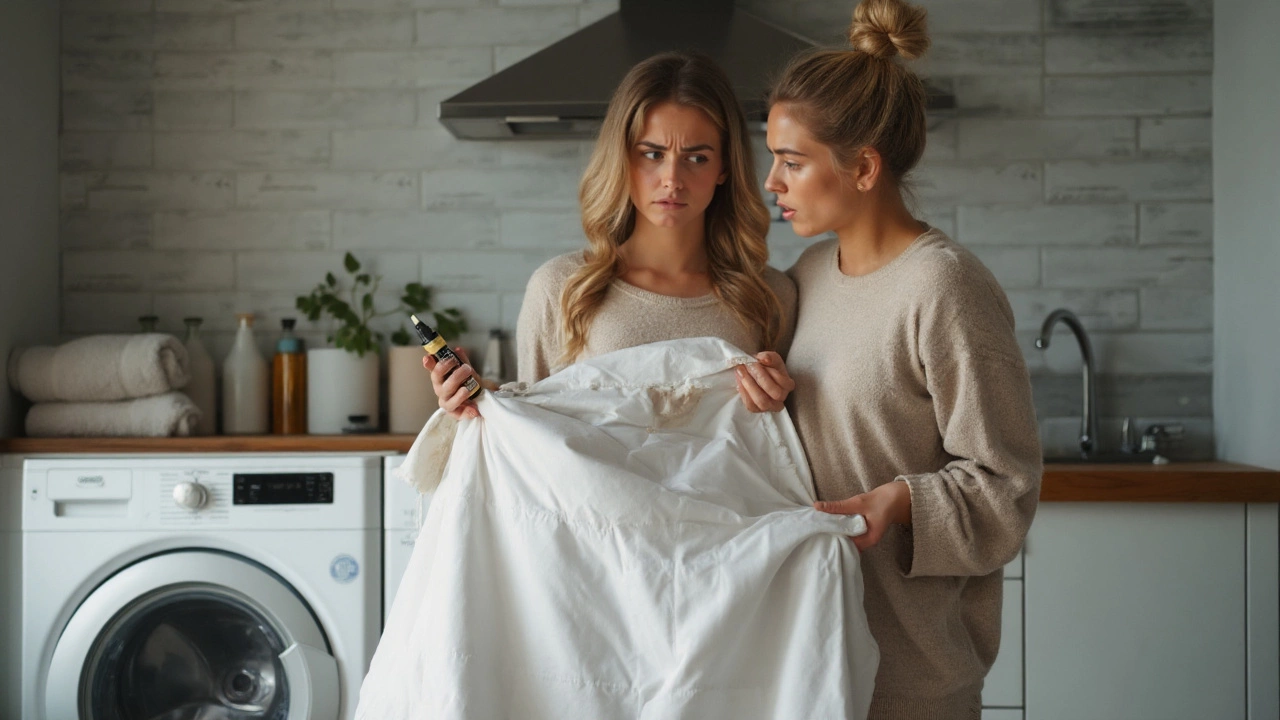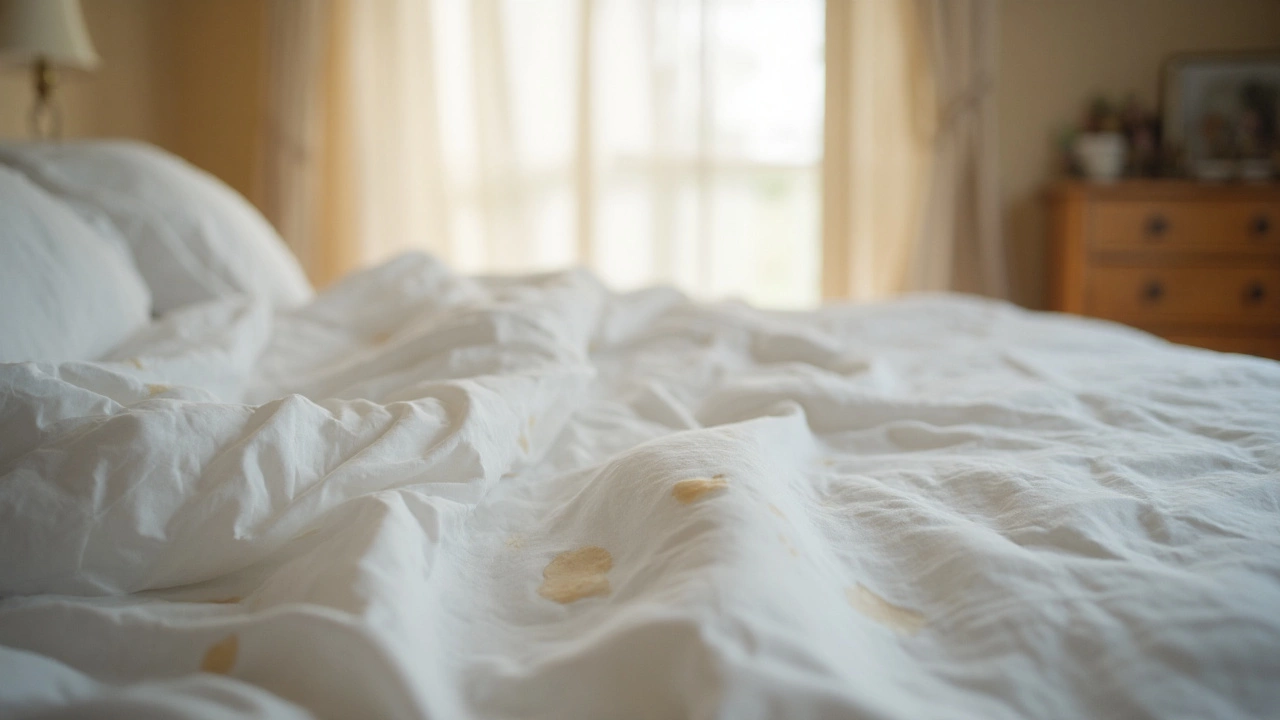Ever found a suspicious spot on the bedsheets and wondered, “What is that?” You’re not alone. Sperm stains are among the most common yet mysterious marks people stumble across in bedrooms, on underwear, hotel linens, or even on the sofa. Yet, hardly anyone talks about what sperm stains really look like, how they change over time, and the best ways to get rid of them. Let’s get into the messy, often awkward, but surprisingly interesting reality of semen stains, starting with what you actually see when they show up.
What Color Are Sperm Stains Really?
Sperm itself is actually only a small part of what people call semen. Semen is usually an off-white or slightly greyish liquid right after ejaculation. It’s packed with proteins, enzymes, and other stuff your biology teacher probably went over once and hoped you’d forget. When it dries, you’re left with something different. Fresh on sheets or clothing, semen stains look milky white, sometimes just a tad yellow depending on hydration or diet. But things change fast.
Once dry, semen stains generally turn a light yellow, off-white or pale beige hue. This color shift happens because the proteins and minerals in the fluid oxidize as they interact with air. The stain can become faint depending on how much there was and how absorbent the fabric is. On white cotton sheets, a dry sperm stain can look a bit like a water mark or subtle yellow halo—nothing dramatic, but definitely there if you know what you’re looking for. On dark fabrics, you might barely see it at all, but in the right light, there can be a slightly shiny or stiff patch.
Temperature, washing, and time all affect how visible the stains are. If the stain’s been there for a while, it can set and darken a bit, getting more yellow or even brownish (nobody likes that look). If a person is ill or takes certain vitamins, the stain can be darker or even have an odd greenish cast, but that’s rare.
Sperm stains also show up on surfaces differently depending on the material. On delicate silk, it can leave a shadowy patch. On rough upholstery, sometimes it beads up first, then dries crusty. Many people have accidentally found old stains only when they’ve pulled out sheets or trousers in sunlight, realizing there’s a patch where the color and fabric texture don’t quite match the rest.
| Stage | Semen/Sperm Color | Description/Notable Features |
|---|---|---|
| Freshly ejaculated | White to greyish | Milky, slightly viscous |
| Few minutes old | Changing to off-white or pale yellow | Starts absorbing or pooling on fabric |
| 1-3 hours later | Pale yellow or beige | Crusty texture, more visible on white fabrics |
| Few days+ (not cleaned) | Yellow, sometimes brownish | Can produce a stiff, rough patch on fabric |
If you’ve ever compared a spill from milk and a semen stain, you might have noticed something: both can dry yellowish, but milk tends to smell a bit after a while. Semen stains have a faint musky odor when fresh, which usually fades after drying, so unless you’re sniffing suspiciously, you’d barely notice. Knowing all this, spotting a sperm stain isn’t always about color—it’s also about texture and a slight sheen in the right light.
What Factors Change How Sperm Stains Appear?
Lots of people think a stain is a stain, but sperm stains are more complicated than you’d guess. The exact look depends on several things: what the person has eaten, how hydrated they are, any medications they take, and the fabric type. Have you ever noticed that some laundry stains just refuse to budge, while others fade quickly? That’s no accident. High-protein diets or supplements can make semen thicker, leading to more stubborn marks. Medications, like antibiotics or supplements high in vitamin B, might even tweak the color slightly—turning stains just a hint more yellow.
Fabric plays a starring role, too. Cotton spreads stains more evenly, so they dry larger and lighter. Polyester and nylon tend to repel fluids at first, making the stain bead up before it seeps in, often looking stark and dry. Old-school satin pillowcases? Stains stay close to the surface, often easy to spot but also easier to wipe away if you catch them quick.
Here’s the kicker: time is not your friend. The longer you leave a semen stain, the tougher it will be to remove and the more the color will shift. Air oxidizes those proteins, going from creamy-white to a dark yellow within hours or days, especially in warm, humid rooms. Ever tried to wash out a week-old mystery stain and ended up making it worse? That’s dried semen for you—it grabs onto fabric fibers and won’t let go.
Light also matters. Under regular indoor lighting, dried sperm stains can be nearly invisible, especially on light or busy-patterned fabrics. Hit them with UV light (yep, like the ones in crime shows), and they glow, which is why they catch so many people off guard during hotel or flat inspections. If you need to check, a cheap UV torch can show you more stains than you really want to find.
If you’re curious whether any household substances look similar to sperm stains, egg whites come pretty close, but even those wash out easier. Compared to most kitchen spills, semen stains cling because of the combination of sugars, proteins, and fats—all working together to make the stain stubborn. People sometimes mistake lotion or moisturiser stains for semen, as both can dry with a sheen, but lotion wipes off with water far easier.

How to Identify a Sperm Stain Versus Other Common Stains
Let’s be honest—a pale yellow patch on sheets could be from all sorts of things. Sweat, food spills, hair product, you name it. So how do you tell if it’s really a sperm stain and not someone’s dessert from last week? First, check the location. Sperm stains tend to pop up where skin meets fabric (middle of the bed, underwear, pyjama bottoms, sofa cushions). Sweat stains usually show up around collars, armpits, or wherever your body sits for a while—but they’re usually more yellow and cover bigger areas.
If the stain feels stiff or crusty, especially if the patch is well defined and not spread out, you’re likely dealing with semen. Semen stains often become rough and keep a slightly raised edge after drying. They also have a sticky phase before fully setting, so if you touch a stain and it feels tacky, it’s probably fresh. Over time, as the proteins break down, it gets flaky and hard.
Testing a mysterious stain is risky, but for those curious, here are a few basic checks:
- Hold the fabric at an angle under strong light. Sperm stains sometimes catch the light thanks to the dried protein, giving off a dull shine.
- Rub the spot gently. If it flakes or releases a powdery residue, it’s probably old semen, not a food spill.
- Use cold water on a small corner. If it dissolves quickly, the stain is likely recent and probably semen, as old stains need detergent to shift.
- Sniff test (approach with caution). Fresh semen has a slightly bleachy or musky scent that disappears as it dries.
Another tip: laundry detergents made for protein-based stains (like blood or egg) handle semen much better than basic soaps. If you suspect you’re dealing with a sperm stain, resist the urge to rub it in. That pushes the proteins deeper into the fabric, making the stain permanent.
Hotels, rental flats, and even launderettes in large cities have UV lights for checking mystery stains. If you’re ever in doubt and don’t want an awkward conversation or a headache deposit deduction, it’s the fastest way to confirm what you’re dealing with. One study from a cleaning service in London found nearly 60% of “suspicious” stains on hotel mattresses turned out to be semen after UV checks—it’s far more common than anyone admits.
Cleaning Tips and Prevention: Dealing with Sperm Stains
So, you’ve found a stain and think it’s dried semen. Don’t panic—the world isn’t ending. The key is acting as soon as possible. Protein-based stains like semen are easiest to remove when fresh. Cold water is your best friend—never use hot right away, as it can set the stain for good.
Here’s a step-by-step guide for cleaning up the mess, whether it’s on clothes, bedsheets, or a sofa cushion:
- Blot up any excess with tissue or a clean towel. Don’t scrub—you’ll just mash the stain deeper.
- Rinse the area thoroughly with cold water. Hold the fabric under a running tap or pour water over the patch.
- Apply a bit of mild, enzymatic detergent directly onto the stain. Rub it in gently with your fingers.
- Let it sit for 10-15 minutes, then rinse again thoroughly with cold water.
- Wash with the rest of your laundry in the machine at the temperature recommended by the care label, ideally 30-40°C.
- If you still see the stain, don’t use the tumble dryer yet! Drying can set protein stains. Repeat the treatment above until the patch fades.
Certain materials, like silk, wool, or vintage upholstery, need extra care. Test any cleaner on a hidden spot first. For mattresses, use an upholstery cleaner or diluted washing-up liquid gently worked into the fabric, then blot with cold water. Allow it to air dry fully.
If you find yourself battling sperm stains often, you might want to keep enzyme-based stain removers on hand. They’re specially designed to break down the proteins and sugars in semen and work far better than just soap and water. No need to splash out on fancy brands—the supermarket cheapies do the job if they’re meant for protein stains. Sprinkle baking soda on the spot if you need to soak up any odor after cleaning, then vacuum it off when dry.
DIY tip: Hydrogen peroxide (the stuff in first aid kits) can help lighten stains on colorfast white fabrics, but always spot-test before going wild. Never mix bleach and ammonia-based products—some biological stains react badly, plus the fumes can be dangerous.
Of course, the best cleaning is prevention. If you’re worried about sheets or expensive bedding, lay down a towel or have a dedicated “messy night” set you don’t mind getting stained. Quick action is the magic bullet—waiting means that dry yellow stain becomes a permanent reminder you didn’t need.
Sperm stains are awkward but absolutely normal, and they’re way more common than people think. Whether on a pillowcase, pair of jeans, or the hotel mattress, now you know what color they are, why they change, and how to banish them for good.
